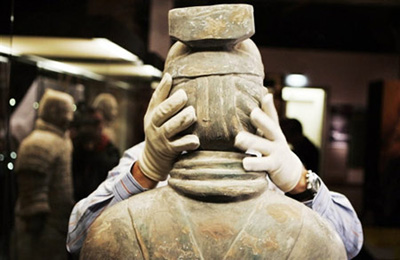Chinese cultural officials on Thursday said they are considering legal action against the German exhibitors of fake Chinese terracotta army statues, which they describe as a "fraud."
"It is a serious act of fraud and has implications for intellectual property rights," said Chen Xianqi, a spokesman for the Shaanxi Provincial Bureau of Cultural Heritage, in Xi'an, home of the 2,200-year-old terracotta army.
An exhibition of the Chinese terracotta army, titled "Power in Death", has been held in the city of Hamburg since Nov. 25. The exhibitors have claimed that the Shaanxi bureau was one of the organizers, and the eight clay warrior figures and two horses on display had been transported from China and were "authentic".
"The museum of the terracotta army in Xi'an has not sent any authentic objects for purposes of display to Germany recently, and currently no such relics are on display in Germany," said Chen, also director of the Shaanxi Provincial Cultural Heritage Exchange Center.
"The bureau knew nothing about the exhibition. The Hamburg Museum of Ethnology and the German Center of Chinese Arts and Culture have organized the exhibition. They did not consult us," he said.
On Wednesday the German news agency dpa quoted Yolna Grimm, from the Center of Chinese Arts and Culture, as saying that the Center had never said the figures were original, but rather that they were "authentic". "To us, authentic means they are ceramic, life-sized and comparable with the originals."
Chen said China had strict regulations covering the transport of Chinese cultural relics overseas for exhibitions. Items must be approved by the local or national cultural heritage authorities first and then by the Ministry of Culture or the State Council, China's cabinet.
He said the center had organized two exhibitions of the terracotta army in Germany in the past two years. "The objects on display have all been returned to China."
An exhibition was held from April 21 to July 23 last year in Bonn and the items were returned in August of the same year. Another exhibition was held in Leipzig from April 28, 2005, to Feb. 28, 2006, and was later extended to earlier this year, before the relics returned home in April, Chen said.
"The two exhibitions both won acclaim from the German public," he said.
The terracotta army buried around the mausoleum of China's first emperor, Qin Shihuang, was one of the greatest archeological finds of modern times. In 1974 peasants who were digging a well in Lintong County, 35 km east of Xi'an, made the discovery.
More than 1,000 life-size figures were found, representing the emperor's army, including officers, horses, archers, and chariots. No two figures are identical. Each of the sand-colored statues has a different facial expression and hairstyle, and craftsmen are believed to have modeled them after a real army.
The discovery, listed as a world heritage site by UNESCO since December 1987, has turned Xi'an, capital of the northwestern Shaanxi Province, into one of the nation's major tourist attractions.
A museum opened in 1979 that covers the original excavation site, thus leaving the repaired soldiers where they were found. It has since received about 60 million visitors, including at least six million from abroad.
A terracotta army exhibition opened at London's British Museum on Sept. 13 and will run till April 6 of next year. It comprises 120 artifacts, including 20 life-size warriors. It is the largest exhibition of the terracotta army ever to be seen outside China.
(Xinhua News Agency December 14, 2007)



